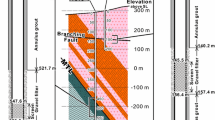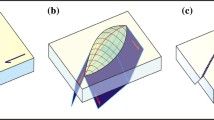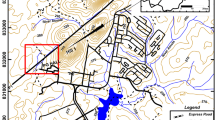Abstract
The hydrogeologic influence of the Elkhorn fault in South Park, Colorado, USA, is examined through hydrologic data supplemented by electrical resistivity tomography and self-potential measurements. Water-level data indicate that groundwater flow is impeded by the fault on the spatial scale of tens of meters, but the lack of outcrop prevents interpretation of why the fault creates this hydrologic heterogeneity. By supplementing hydrologic and geologic data with geoelectrical measurements, further hydrogeologic interpretation is possible. Resistivity profiles and self-potential data are consistent with the interpretation of increased fracturing within 70 m of the fault. Further interpretation of the fault zone includes the possibility of a vertical groundwater flow component in a fractured and relatively high permeability damage zone and one or more relatively low permeability fault cores resulting in a conduit-barrier behavior of the fault zone at the meter to tens-of-meters scale. Calculated hydraulic heads from the self-potential data reveal additional complexity in permeability structure, including a steeper hydraulic gradient immediately west of the interpreted fault trace than suggested by the well data alone.
Résumé
L’incidence hydrogéologique de la faille Elkhorn dans South Park, Colorado, USA, est examinée à l’aide de données hydrogéologiques complétées par tomographie électrique et mesures de potentiel spontané. Les données piézométriques indiquent que l’écoulement de la nappe est perturbé à l’échelle spatiale d’une dizaine de mètres, mais l’absence d’affleurement empêche d’interpréter cette hétérogénéité hydrogéologique. En complétant les données hydrogéologiques par des mesures géoélectriques, on peut progresser dans l’interprétation. Les données des profils de résistivité et potentiel spontané s’accordent avec l’existence d’une fracturation croissante à 70 m de la faille. Une autre représentation de la zone faillée inclut l’existence d’une zone fracturée à perméabilité perturbée relativement forte, avec composante verticale possible de l’écoulement, et d’un ou plusieurs corps faillés de perméabilité faible formant barrière à l’échelle du mètre ou de la dizaine de mètres. Les charges hydrauliques déduites des mesures de potentiel spontané révèlent la complexité de la structure, avec, immédiatement à l’Ouest du tracé supposé de la faille, un gradient hydraulique plus élevé que celui suggéré par les seules données de forage.
Resumen
Se examina la influencia hidrogeológica de la falla de Elkhorn en South Park, Colorado, EEUU, a través de datos hidrológicos provistos por la tomografía de resistividad eléctrica y las medidas de potencial espontáneo. Los datos de nivel de agua indican que el flujo de aguas subterráneas se halla impedido por la falla a la escala espacial de decenas de metros, pero la falta de afloramiento impide la interpretación de porque la falla crea esta heterogeneidad hidrológica. Complementando los datos hidrológicos y geológicos con las medidas geoeléctricas, es posible una interpretación hidrogeológica ulterior. Los datos de perfilajes de resistividad y potencial espontáneo son consistentes con la interpretación de la fracturación incrementada dentro de los 70 metros de la falla. La interpretación ulterior de la zona de falla incluye la posibilidad de una componente de flujo vertical de aguas subterráneas en una zona de daño fracturada de relativamente alta permeabilidad y uno o más núcleos de falla de relativamente baja permeabilidad que resulta en un comportamiento de una barrera de conducto de la zona de falla a escala de metro a decenas de metros. Las cargas hidráulicas calculadas a partir de los datos de potencial espontáneo revelaron una complejidad adicional en la estructura de permeabilidad, incluyendo un gradiente hidráulico más abrupto inmediatamente al oeste de la traza interpretada de falla que el sugerido por solamente los datos de los pozos.
摘要
根据水文数据并辅以电阻率层析成像和自然电位测量, 研究了位于美国克罗拉多州South Park 的Elkhorn断裂的水文地质效应。水位数据显示, 地下水流为数十米规模的断裂所阻, 但因缺少露头, 难以解释该断裂是如何造成水文非均质性的。通过地电测量对水文和地质数据进行补充, 使得进一步的水文地质解译成为可能。电阻率剖面和自然电位数据与断裂70米内破裂增强的解译一致。对该断裂带的进一步解译有 : 可能有一股存在于某一渗透性较高破碎带中的垂向地下水流, 及一个或多个渗透性较低断层核心所造成的米至数十米尺度的阻水断裂带。由自然电位数据算得的水位揭示出更为复杂的渗透性结构, 如在紧邻解译出的断层迹线的西侧, 发现其水力梯度比单凭井数据解释出来的更陡。
Resumo
É analisada a influência hidrogeológica da falha Elkhorn em South Park, Colorado, EUA, através de dados hidrológicos complementados por tomografia de resistividade eléctrica e por medições de potencial espontâneo. Dados de nível de água indicam que o fluxo das águas subterrâneas é dificultado pela falha numa escala espacial de dezenas de metros, mas a falta de afloramento impede a interpretação do modo como a falha cria essa heterogeneidade hidrológica. Complementando os dados geológicos e hidrológicos com medições geoeléctricas, é possível apoiar uma interpretação hidrogeológica. Perfis de resistividade e dados de potencial espontâneo são consistentes com a interpretação de um aumento da fracturação numa extensão lateral de 70 metros partir da falha. Além disso, a interpretação da zona de falha inclui a possibilidade de uma componente vertical de fluxo de águas subterrâneas numa zona fracturada e de esmagamento com relativamente elevada permeabilidade e um ou mais núcleos da falha de relativa baixa permeabilidade, resultando num comportamento barreira-condutiva da zona de falha à escala métrica a dezenas de metros. Potenciais hidráulicos calculados a partir de dados de potencial espontâneo revelam complexidade adicional na permeabilidade da estrutura, incluindo um acentuado gradiente hidráulico imediatamente a oeste do lineamento interpretado da falha, o que é sugerido também, por si só, pelos dados dos furos.





Similar content being viewed by others
References
Ahlers CF, Finsterle S, Bodvarsson GS (1999) Characterization and prediction of subsurface pneumatic response at Yucca Mountain, Nevada. J Contam Hydrol 38(1–3):47–68
Antonellini M, Aydin A, Orr L (1999) Outcrop-aided characterization of a faulted hydrocarbon reservoir: Arroyo Grande Oil Field, California, USA. Geophys Monogr 113:7–26
Arora T, Linde N, Revil A, Castermant J (2007) Non-intrusive characterization of the redox potential of landfill leachate plumes from self-potential data. J Contam Hydrol 92(3–4):274–292
Aubert M, Atangana QY (1996) Self-potential method in hydrogeological exploration of volcanic areas. Ground Water 34(6):1010–1016
Bense VF, Person MA (2006) Faults as conduit-barrier systems to fluid flow in siliciclastic sedimentary aquifers. Water Resour Res 42(5):18
Birch FS (1998) Imaging the water table by filtering self-potential profiles. Ground Water 36(5):779–782
Bredehoeft JD, Belitz K, Sharphansen S (1992) The hydrodynamics of the Big Horn Basin: a study of the role of faults. AAPG Bull 76(4):530–546
Bruce BW, Kimbrough RA (1999) Hydrologic and water-quality data for surface water, ground water, and springs in north-central Park County, Colorado, April 1997–November 1998. US Geol Surv Open File Rep 99–183
Bryant B, Naeser CW (1980) Significance of fission-track ages of apatite in relation to the tectonic history of the Front and Sawatch Ranges, Colorado. Bull Geol Soc Am 91(3):156–164
Bryant B, McGrew L, Wobus RA (1981) Geologic map of the Denver 1 × 2 quadrangle, north-central Colorado. US Geol Surv Misc Invest I-1163
Caine JS, Forster CB (1999) Fault zone architecture and fluid flow: insights from field data and numerical modeling. Geophys Monogr 113:26
Caine JS, Evans JP, Forster CB (1996) Fault zone architecture and permeability structure. Geology 24(11):1025–1028
Chapman JB, Lewis B, Litus G (2003) Chemical and isotopic evaluation of water sources to the fens of South Park, Colorado. Environ Geol 43(5):533–545
Chester FM, Logan JM (1986) Implications for mechanical properties of brittle faults from observations of the Punchbowl Fault Zone, California. Pure Appl Geophys 124(1–2):79–106
Evans JP, Forster CB, Goddard JV (1997) Permeability of fault-related rocks, and implications for hydraulic structure of fault zones. J Struct Geol 19(11):1393–1404
Forster CB, Evans JP (1991) Hydrogeology of thrust faults and crystalline thrust sheets: results of combined field and modeling studies. Geophys Res Lett 18(5):979–982
Fournier C (1989) Spontaneous potentials and resistivity surveys applied to hydrogeology in a volcanic area: case history of the Chaine des Puys (Puy-de-Dome, France). Geophys Prospect 37:647–668
Ge S, Garven G (1994) A theoretical model for thrust induced deep groundwater expulsion with application to the Canadian Rocky Mountains. J Geophys Res Solid Earth 99(B7):13851–13868
Ge S, Liu MA, Lu N, Godt JW, Luo G (2009) Did the Zipingpu Reservoir trigger the 2008 Wenchuan earthquake? Geophys Res Lett 36:L20315
Grant FS, West GF (1965) Interpretation theory in applied geophysics: part 3, electrical conduction and electromagnetic induction methods. McGraw-Hill, New York
Haneberg WC (1995) Steady-state groundwater flow across idealized faults. Water Resour Res 31(7):1815–1820
Jackson D B, Kauahikaua J (1987) Regional self-potential anomalies at Kilauea volcano. US Geol Surv Prof Pap 1350
Jardani A, Revil A, Bolève A, Crespy A, Dupont JP, Barrash W, Malama B (2007) Tomography of the Darcy velocity from self-potential measurements. Geophys Res Lett 34(24), L24403
Leroy P, Revil A (2004) A triple-layer model of the surface electrochemical properties of clay minerals. J Colloid Interface Sci 270(2):371–380
Linde N, Revil A (2007) Inverting self-potential data for redox potentials of contaminant plumes. Geophys Res Lett 34, L14302. doi:10.1029/2007GL030084
Linde N, Revil A, Bolève A, Dages C, Castermant J, Suski B, Voltz M (2007) Estimation of the water table throughout a catchment using self-potential and piezometric data in a Bayesian framework. J Hydrol 334(1–2):88–98
Lockner D, Naka H, Tanaka H, Ito H, Ikeda R (2000) Permeability and strength of core samples from the Nojima Fault of the 1995 Kobe earthquake. US Geol Surv Open File Rep 2000-129
Loke MH, Barker RD (1994) Rapid least-squares inversion of apparent resistivity pseudosections by a quasi-Newton method. Geophys Prospect 44(1):131–152
Lopez DL, Smith L (1995) Fluid flow in fault zones: analysis of the interplay of convective circulation and topographically driven groundwater flow. Water Resour Res 31(6):1489–1503
Lopez DL, Smith L (1996) Fluid flow in fault zones: influence of hydraulic anisotropy and heterogeneity on the fluid flow and heat transfer regime. Water Resour Res 32(10):3227–3235
Marler J, Ge S (2003) The permeability of the Elkhorn Fault Zone, South Park, Colorado. Ground Water 41(3):321–332
Mayer A, May W, Lukkarila C, Diehl J (2007) Estimation of fault-zone conductance by calibration of a regional groundwater flow model: Desert Hot Springs, California. Hydrogeol J 15(6):1093–1106
McLaughlin TG (1946) Permeability of water-bearing materials. In:Geology and ground-water resources of Grant, Haskell, and Stevens Counties, Kansas. Bull Kans State Geol Surv 61
Naudy H, Dreyer H (1968) Non-linear filtering applied to aeromagnetic profiles. Geophys Prospect 16(2):171–178
Revil A, Leroy P (2001) Hydroelectric coupling in a clayey material. Geophys Res Lett 28 (8):1643-1646
Revil A, Linde N (2006) Chemico-electromechanical coupling in microporous media. J Colloid Interface Sci 302:682–694
Revil A, Cathles LM, Losh S, Nunn JA (1998) Electrical conductivity in shaly sands with geophysical applications. J Geophys Res Solid Earth 103(B10):23925–23936
Revil A, Hermitte D, Voltz M, Moussa R, Lacas JG, Bourrié G, Trolard F (2002) Self-potential signals associated with variations of the hydraulic head during an infiltration experiment. Geophys Res Lett 29(7), 1106, doi:10.1029/2001GL014294
Ruleman CA, Bohannon RG (2008) Geologic map of the Elkhorn quadrangle, Park County, Colorado. US Geol Surv Sci Invest Map 3043
Sato M, Mooney HM (1960) The electrochemical mechanism of sulfide self-potentials. Geophysics 25:226–249
Sawatzky DL (1964) Structural geology of southeastern South Park, Park County, Colorado. Mt Geologist 1(3):133–139
Shipton ZK, Cowie PA (2001) Damage zone and slip-surface evolution over μm to km scales in high-porosity Navajo sandstone, Utah. J Struct Geol 23(12):1825–1844
Shipton ZK, Cowie PA (2003) A conceptual model for the origin of fault damage zone structures in high-porosity sandstone. J Struct Geol 25(3):333–344
SilL WR (1983) Self-potential modeling from primary flows. Geophysics 48(1):76–86
Stark JT, Johnson JH, Behre CH Jr, Powers WE, Howland AL, Gould DB (1949) Geology and origin of South Park, Colorado. Mem Geol Soc Am 33:173
Suski B, Revil A, Titov K, Konosavsky P, Voltz M, Dagès C, Huttel O (2006) Monitoring of an infiltration experiment using the self-potential method. Water Resour Res 42(8), W08418
Theis CV (1935) The relation between the lowering of the piezometric surface and the rate and duration of discharge of a well using ground water storage. Trans Am Geophys Union 16:519–524
Yang J, Large RR, Bull SW (2004) Factors controlling free thermal convection in faults in sedimentary basins: implications for the formation of zinc-lead mineral deposits. Geofluids 4(3):237–247
Zablocki CJ (1978) Streaming potentials resulting from the descent of meteoric water: a possible source mechanism for Kilauean self-potential anomalies. Trans Geotherm Resour Counc 2(2):747–748
Zohdy AAR (1974) Electrical methods. In: Zohdy AAR, Eaton GP, Mabey DR (eds) Application of surface geophysics to ground-water investigations. US Geol Surv Tech of Water Resour Invest 2-D1, pp 5–66
Acknowledgements
This work was funded under National Science Foundation grant EAR610027 to S. Ge and J.S. Caine. Additional field support was graciously provided by the American Water Resources Association Richard Herbert Memorial Scholarship, the Colorado Ground-Water Association Harlan Erker Memorial Scholarship, the Department of Geological Sciences at the University of Colorado at Boulder, and the U.S. Geological Survey Minerals and Toxics Programs. The authors thank J. Medema for allowing access to the well site and M. McHugh for providing borehole data. Additional thanks are extended to B. Minsley and A. Manning for their valuable comments on the early draft of this paper, and to R. van Balen and J. Turner for their helpful reviews.
Author information
Authors and Affiliations
Corresponding author
Rights and permissions
About this article
Cite this article
Ball, L.B., Ge, S., Caine, J.S. et al. Constraining fault-zone hydrogeology through integrated hydrological and geoelectrical analysis. Hydrogeol J 18, 1057–1067 (2010). https://doi.org/10.1007/s10040-010-0587-z
Received:
Accepted:
Published:
Issue Date:
DOI: https://doi.org/10.1007/s10040-010-0587-z




